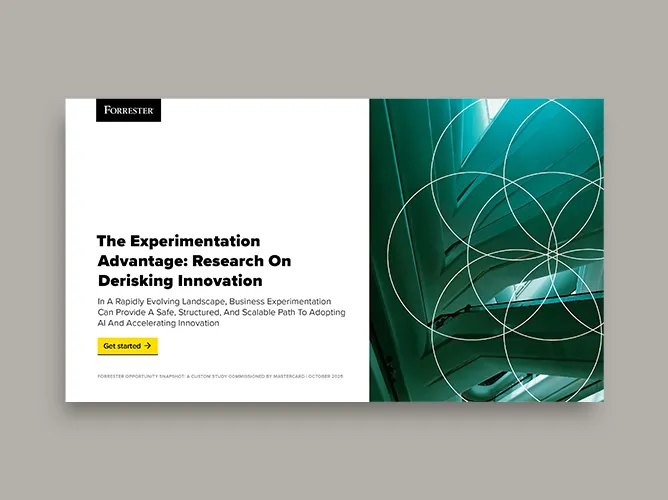Mastercard Payments Trends Navigator is a bi-annual report that draws on Mastercard’s extensive expertise in the payments industry to highlight the top trends and developments in global payments and banking.
Access Mastercard Business Intelligence

Trend 1: Alternative payment methods are growing in popularity
‘Alternative payment methods’ encompass a wide range of payment options that do not require physical cards, cash or cheques.
The most popular alternative payment methods include:
- Digital wallets
- Peer-to-peer (P2P) payment platforms
- QR code-based payments
- Buy now, pay later
The underlying payment infrastructures that power alternative payments include:
- Established rails – including card rails and batch payment systems
- Emerging rails – including real-time payments and blockchain-based crypto networks
Alternative payment method adoption continues to grow globally. This has been driven by government initiatives to boost financial inclusion and resilience, as well as evolving consumer and business preferences for payment options that are:
- Flexible
- Convenient
- Fast
- Secure
- Omnichannel
Source: Introspective Market Research
Source: Juniper Research
Source: Worldpay’s Global Payments Report

Key opportunity
Push-to-card solutions such as Mastercard Move enable near real-time transfers globally (including for remittances and disbursements) between banks, their customers and end recipients, with limited integration effort.
Trend 2: Next-generation personal finance management with proactive, hyper-personalized features unlocks customer engagement
Banks have, historically, been the primary financial service providers for consumers. But, as the digital landscape continues to evolve, this prime position is no longer a guarantee of customer engagement.
The popularity of personal finance management solutions has surged, creating a paradigm shift in retail banking customer engagement.
Today, customers expect more than a passive, ‘do-it-yourself’ tool that merely tracks their financial habits.
They want proactive insights and actionable suggestions to:
- help them make informed decisions
- save more efficiently
- optimize their financial well-being
Source: Adjust
Source: Capgemini

While fintech companies and neobanks have led the charge in developing next-generation personal finance management offerings, incumbent banks have the opportunity to enhance their engagement by focusing on proactive customer engagement features.
Key customer engagement features
- Tailored and automated savings
- Advanced subscription management
- Personalised loyalty programmes and rewards
- AI-powered chatbots and digital assistants
When leveraging consumer data, it's paramount that financial institutions adhere to the highest standards of data and tech responsibility. Explore Mastercard’s Data & Tech Responsibility Principles.
Trend 3: Fintechs and independent software vendors are capturing significant market share of SME acquiring
Incumbent merchant acquirers are facing intensifying competition from neobanks, payment facilitators, independent software vendors and e-commerce marketplaces particularly in the micro and small business segment.
Fintechs and other emerging players have been able to create successful value propositions by providing a single touchpoint for more of their business needs.
Emerging business models
- Verticalization of offerings
- ‘SuperApp’ approach
- ‘Marketplace’ approach
Incumbent banks generate revenue from processing transactions, but there is a large and growing revenue opportunity from value-added services.
Features of successful merchant acquirers for SME segment
- Shift away from a reactive and broad-based approach
- Identify key SME customer groups
- Assess internal capabilities
- Enhance core offerings to make them more digital and convenient
- Expand value-added services offerings, tailored to the identified SME customer groups
Source: BCG
Source: Pollinate Merchant Research
Source: McKinsey
Trend 4: Alternative credit data and solutions unlock financial inclusion and profitability
Traditional credit data is a cornerstone of lending decisions. However, many lenders are turning to additional data sources to gain a comprehensive view of borrowers’ financial lives.
‘Alternative credit data’ allows financial providers to assess creditworthiness from a diverse range of customer-permissioned and public data sources, including (non-exhaustive):
Source: Datos Insights
| Consumers | Small businesses |
|---|---|
| Bank account transaction data (including cash flow data) | Accounting and cash flow data |
| Income and payroll data | Point-of-sale data |
| Bills and utility history | Supplier payment records |
| Employment and education | Inventory turnover |
| Healthcare payments | Business licenses |
| Shopping and lifestyle data | Bills and utility payment history |
| Mobile phone data | Customer reviews |
| Social media activity | Social media activity |
| BNPL data | E-commerce data |
| Market reports |

This allows lenders to get a deeper insight into borrowers both with and without traditional credit information thereby unlocking new growth opportunities.
By combining alternative credit with key technological innovations, lenders can address the evolving needs of borrowers.
Key borrower expectations
- Seamless, digital borrower application experience
- Instant or fast credit approvals, including credit line matched to customer ability to pay
- Personalized products
- Streamlined and automated compliance process
- Pre-qualified offers
- Simple and transparent repayment options
Trend 5: Data analytics powers cardholder retention and reactivation
Consumers have an ever-greater choice of debit and credit card providers, products and offers.
As competition intensifies, successful issuers are adopting a proactive, data-driven approach to improving cardholder retention and deepening the customer relationship.
The main cause of cardholder churn in today’s competitive environment is dissatisfaction with rewards and cashback offers8. However, other significant factors include:
- Higher credit limit with a competing card
- Convenient and digital application process
- Zero or low interest rate
- Card benefits, including savings, travel, insurance and ESG
- Card controls and security
- Card design

Getting ahead of this churn by using data analytics is critical for protecting revenues and market share.
Four effective retention and reactivation strategies
- Leverage data and analytics to identify high value cardholders based on spend and behavioral metrics
- Understand and analyse specific triggers that lead to customer attrition
- Proactively deliver highly relevant and personalized retention strategies, targeted at the right profitable segments
- Implement, measure performance and optimize retention strategies
Source: Datos Insights
Source: Mastercard, Turnkey dashboard
Mastercard’s continuous aim is to help people better understand and navigate the complex world of payments. Access the full insights from our Mastercard Payments Trends Navigator today.
2Fintech Futures. ‘P2P Payments Market,’ 2024.
3Juniper Research. ‘Global QR code payments market 2023-2028,’ 2024.
4Adjust. ‘The finance app insights report,’ 2024.
5Capgemini. ‘Velocity meet value,’ 2024.
6BCG. ‘Global Payments Report,’ 2023.
7Pollinate Market Research. ‘Merchant Acquiring: Why now?,’ 2023.
8McKinsey. ‘As ISVs disrupt payments, can merchant acquirers stay relevant?,’ 2022.
9Datos Insights. ‘The Rise of Alternative Credit Data,’ 2024.
10Datos Insights. ‘U.S.Credit Cards Fight to Stay Relevant: A Financial Behaviors Series Report,’ 2024.











